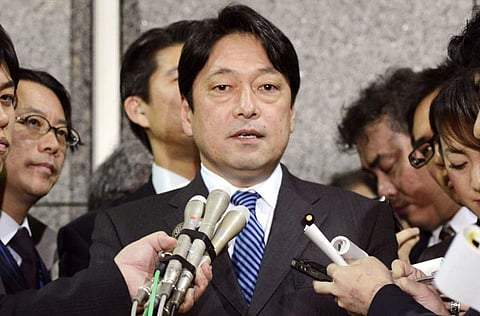Japan protests after China points radar at vessel
Incident could complicate path to summit

Tokyo: A Chinese navy vessel aimed a type of radar normally used to aim weapons at a target at a Japanese navy ship in the East China Sea, prompting Japan to protest, Japan’s defence minister said on Tuesday, an action that could complicate efforts to cool tension in a territorial row between the rivals.
“Projecting fire control radar is very unusual,” Japanese Defence Minister Itsunori Onodera told reporters of the incident, which he said occurred on January 30 but took time to confirm.
“One mistake, and the situation would become very dangerous.”
Prime Minister Shinzo Abe, however, told Onodera it was important to respond calmly and not meet provocation with provocation, Kyodo news agency reported.
Hopes have been rising for a thaw in ties between Asia’s two biggest economies since a chill began in September when Tokyo nationalised a chain of rocky, uninhabited isles in the East China Sea.
In particular, there are hopes for a leaders’ summit to help ease the strains that a junior Japanese coalition partner said on Tuesday could take place as early as April.
But deep mistrust, simmering nationalism in both countries and bitter Chinese memories of Japan’s wartime aggression mean the road to a summit will be rocky and any rapprochement fragile.
Onodera said a similar incident may have occurred on January 19, when a Chinese naval ship may have directed so-called fire control radar at a Japanese navy helicopter.
The long-running row over the islands, known as the Senkaku in Japan and the Diaoyu in China, has in recent months escalated to the point where both sides have scrambled fighter jets while patrol ships shadow each other.
Chinese officials were not available for comment on Japan’s complaint about the radar, but a Chinese spokeswoman earlier urged Japan to stop what she called provocation.
“We believe that what is most urgent is for Japan to stop provocative actions like regularly sending in ships and aircraft into the waters around the Diaoyu Islands — and seek, via talks with China, an effective way to appropriately control and resolve this issue,” Foreign Ministry spokeswoman Hua Chunying told a news conference when asked about Chinese ships operating in waters near the disputed islands.
Fears the cat-and-mouse encounters between aircraft or ships will cause an accidental clash have given impetus to efforts to reduce the tension, including the possible summit between Japanese Prime Minister Shinzo Abe and Chinese leader Xi Jinping, who formally takes over as head of state in March.
Abe’s junior coalition partner, Natsuo Yamaguchi, who heads the small New Komeito party, said a summit could take place as early as April if both sides tried hard to smooth the path.
Yamaguchi met Xi last month to deliver a letter from Abe, who took office in December after his party won an election. Abe, a security hawk who has vowed to stand firm in the islands row, earned a track record of fixing frayed ties with China during his previous 2006-2007 term as prime minister.
“There are two big opportunities,” Yamaguchi told Reuters in an interview, referring to chances for a summit. “One would be when the passage of the budget is assured in Japan.”
Abe’s government aims to enact the budget for the year from April 1 in May, but its passage would be assured once it is approved by parliament’s lower house, which could be in April.
“The other chance is after the [July] upper house election, around the 35th anniversary of the Sino-Japan friendship treaty on August 12,” Yamaguchi said. “Both sides need to make efforts.”
Yamaguchi said the rise of tension over the isles had convinced both sides of the need for dialogue, although he acknowledged that finding a solution was tough.
“Of course, there are different opinions about the Senkaku and it is not easy to reach agreement. Both sides understand that,” he said.
“But if we cannot control things on site, it will be difficult to prevent an accidental incident. The role of politicians is to ease tensions, prevent things from escalating and ... move ahead with aspects of mutual and common interest from a broad perspective.”
Japan’s purchase of the islands from a private citizen was aimed at easing the row but triggered violent protests in China.
Sign up for the Daily Briefing
Get the latest news and updates straight to your inbox



